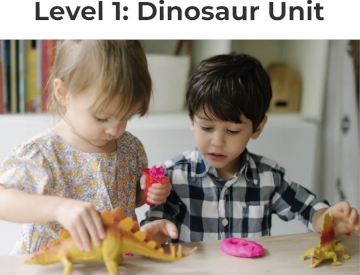Learn + Live Letter offers secular, online unit studies for four levels that are play and project-based. They teach through read-aloud books, discussions, hands-on learning, playtime, projects (building, art, crafts, and science), games, songs, videos, field trips, reading, and writing. The unit studies use many living books in a Charlotte Mason fashion.
Your membership gives you access to all unit studies for four levels. All four levels include activities for reading, math, science, language arts, social studies, art, music, and critical thinking. It might be your complete curriculum for a preschooler, but you will probably add systematic reading and math programs when students are ready. Older students might need to use more-structured language arts resources to cover grammar, vocabulary, handwriting, spelling, and composition. Both science and social studies—history, geography, and cultures—skip around and are not comprehensive, so you might use other resources to fill gaps or provide a structured approach.
- Level 1 (for ages 3-5) offers 37, week-long unit studies that include beginning math and reading skills, such as learning letters and their sounds and addition up to 10.
- Level 2 (for ages 5-7) repeats the same social studies topics as Level 1 at a higher level, making it easy to simultaneously teach students across both levels part of the time. It has 37 week-long units, and academic skills are more advanced than Level 1. For example, students learn both hard and soft sounds for the letter c and multiple-letter phonograms such as igh.
- Level 2+ (for ages 6-8) features 36 week-long unit studies based on countries and nature themes. Academics are slightly more advanced than the previous level.
- Level 3 (for ages 7-12) is quite different from the other levels. It has 18, month-long unit studies, each based on a country and its history and culture. They also include STEM, music, and art activities. At this level, children do either shared or independent reading, and write several types of compositions. (This level is especially good for group classes.) The Usborne Encyclopedia of World History is used in several units along with many other resources.
All levels occasionally include suggestions for younger or older children, marking them with (+) for older students or (-) for younger ones.
The first three levels should each take about a year to complete, although you might take longer if you explore rabbit trails and read more of the recommended books. Level 3 has enough content for about two years.
While the first three levels might require about 20 to 90 minutes per day, Level 3 might require two to four hours per day.
Access to the unit studies is through subscriptions: 30 days, 90 days, or 365 days. Subscribers receive a monthly newsletter that provides guidance for the two units featured for each level that month, and sometimes these align with the seasons of the northern hemisphere. However, you are free to choose whichever units you wish since most of the time they do not build upon one another.
Learn + Live Letter is parent-directed and loosely structured. Because there are books to be acquired for each unit and resources needed for many hands-on activities, prep time is required. A blog post lists 20 common supplies you should have on hand all year for the first three levels and the 14 supplies needed for Level 3, but you will need additional books and supplies for each unit.
Each online unit study begins with a list of the required storybooks (and many non-fiction books for Level 3) and a list of supplies. The unit studies sometimes include links to either YouTube® or Learn + Live Letter read-aloud videos for books when available. The required books are all secular as is the lesson content.
Following these lists are the lessons, complete with embedded links to downloadable activity pages, internet activities, etc. It should be easiest to just work through lessons in the sequence provided, but you don’t have to. Some of the downloads include instructions for parents, but brief instructions for many activities are built into the lesson plans.
To keep track of what children are learning each week, Learn + Live Letter includes a printable Skills Tracker form in each unit. The form lists the suggested books with check-off boxes, then it shows each activity in a chart with space to make notes. Following the chart is a list of subjects covered and skills taught. Finally, there are a few questions to help parents reflect on the week (or month) and record highlights.
Summary
While Learn + Live Letter unit studies rely on books and internet content, they include more projects and hands-on learning than many other unit studies.








